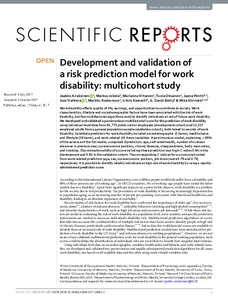Development and validation of a risk prediction model for work disability: multicohort study
Airaksinen J; Jokela M; Virtanen M; Oksanen T; Pentti J; Vahtera J; Koskenvuo M; Kawachi I; Batty GD; Kivimaki M
Development and validation of a risk prediction model for work disability: multicohort study
Airaksinen J
Jokela M
Virtanen M
Oksanen T
Pentti J
Vahtera J
Koskenvuo M
Kawachi I
Batty GD
Kivimaki M
NATURE PUBLISHING GROUP
Julkaisun pysyvä osoite on:
https://urn.fi/URN:NBN:fi-fe2021042717475
https://urn.fi/URN:NBN:fi-fe2021042717475
Tiivistelmä
Work disability affects quality of life, earnings, and opportunities to contribute to society. Work characteristics, lifestyle and sociodemographic factors have been associated with the risk of work disability, but few multifactorial algorithms exist to identify individuals at risk of future work disability. We developed and validated a parsimonious multifactorial score for the prediction of work disability using individual-level data from 65,775 public-sector employees (development cohort) and 13,527 employed adults from a general population sample (validation cohort), both linked to records of work disability. Candidate predictors for work disability included sociodemographic (3 items), health status and lifestyle (38 items), and work-related (43 items) variables. A parsimonious model, explaining > 99% of the variance of the full model, comprised 8 predictors: age, self-rated health, number of sickness absences in previous year, socioeconomic position, chronic illnesses, sleep problems, body mass index, and smoking. Discriminative ability of a score including these predictors was high: C-index 0.84 in the development and 0.83 in the validation cohort. The corresponding C-indices for a score constructed from work-related predictors (age, sex, socioeconomic position, job strain) were 0.79 and 0.78, respectively. It is possible to identify reliably individuals at high risk of work disability by using a rapidly-administered prediction score.
Kokoelmat
- Rinnakkaistallenteet [27094]
